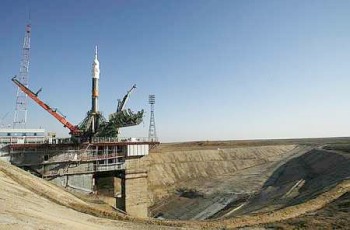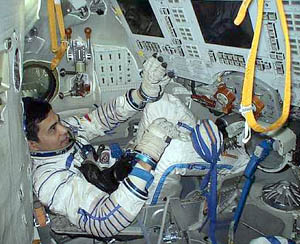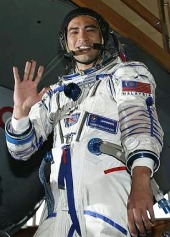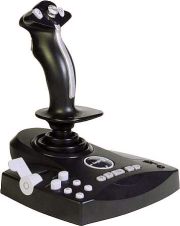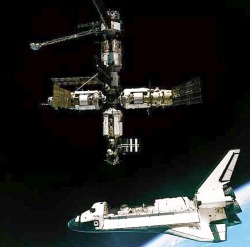Topic: - 6-Part Round-up
AT 9.21 tonight, Malaysia's four-year preparation for the journey into outer space will reach a climax when Dr Sheikh Muszaphar Shukor or Dr Faiz Khaleed launches off into space in the Expedition 16 Soyuz TMA-11 spacecraft from the Baikonur cosmodrome in Kazakhstan.
For the nation, this will mark another milestone in our 50-year history since independence but for Malaysia's first man in space, this will be an experience of a lifetime.
|
SPECIAL VESSEL: The Russian Soyuz TMA-11 spacecraft that will carry a new crew to the International Space Station is mounter on the launch pad at the Baikonur cosmodrome in Kazakhstan. |
Our angkasawan will experience first-hand what it is like to travel into outer space and it is a journey fraught with perils. The human body goes through tremendous physical stress, particularly during take-off. Up to that moment, the body will be under the usual one-G that everyone experiences every day of their lives. When the rocket motors start to roar, our angkasawan will begin to experience an increasing G-force in proportion to the increase in acceleration. This is what large centrifuges here on Earth are meant to replicate and train astronauts for, which in a launching spacecraft means facing up to 8-Gs of force, if only for a few seconds.
This period of high-acceleration will last for 8 to 9 minutes until the rocket ship travels 100km above the Earth and reaches the necessary speed of 18,000mph, sufficient to carry it all the way to the International Space Station (ISS). This will take about 50 minutes after the engines stop firing and during this time, zero-G will prevail and this is when astronauts will experience that sense of weightlessness most people associate with being in space, all whilst staring into the vast blackness of space and the blue horizon of Earth.
Here's an interesting fact about high speeds in space: you can't feel it. If you think of speed on a highway as consisting of visual impressions such as trees flashing by, bumps on the road and air hitting you on the face, once the rocket's engines have shut down and with the immense solitude of space, there are no such "speed sensations". Hence you might not even know if you are moving. But of course you are. At more than 20 times faster than the land speed record of 763mph! The only sense of perspective an astronaut will get is when the rocket approaches the space station and it gets larger and larger in view.
The good news is that once you arrive onboard the ISS, zero-G is nullified as there will be a "synthetic gravity" produced by spinning the space station around its centre. This is a very necessary factor for the well-being of the astronauts as microgravity exposure alters the human body in many ways.
Half of all astronauts suffer space motion sickness when they encounter microgravity and feel as if they are falling. This affects our neurovestibular system, which is what helps our body keep proper orientation while on Earth. This feeling is not dissimilar to the sensation felt after you have been on a terrifying roller-coaster ride. It simply means that your body doesn’t know which way is up, down, left or right.
Another obvious effect of zero-G is a puffy face. This happens because when you are on Earth, gravity concentrates blood in our legs and abdominal cavity while in zero-G, the blood concentrates in the chest and head. Because the human body is made up of 80% fluid, this causes your face to puff up while your lower limbs become skinny from the lack of fluid.
The body's renal/endocrine system, which regulates the amount of fluid in the body, is also affected. In space, the fluid shift tricks the kidneys and several vital glands into believing that the water balance in the body is too high so they start eliminating fluid from the body. Thus astronauts have to re-hydrate themselves frequently, especially before they return to Earth to maintain the correct body fluid balance.
Unsolved mystery
On top of this, during the fluid dump, plasma in the blood system is inadvertently reduced, and in order to balance the ratio of red and white blood cells (especially the lymphocytes which fight infections) and plasma, the brain stops production of red blood cells in the bone marrow. This causes the body to suffer from "space anaemia" (or the lack of red blood cells) upon return to Earth.
In relation to this, there is one mystery which has yet to be solved by scientists. When in space, for some reason, the level of lymphocytes in the body decreases and we do not know why and where they disappear to. This has far-reaching implications for longer space flights in the future. Because these cells fight infections, would astronauts on a voyage to say, Mars, be able to stave off even the weakest of infections? The truth is out there and scientists are still working on it.
But these physical irregularities, which the human body adapts to after a while, pale in comparison to the dangers faced by astronauts from radiation in space. Radiation can alter the chemical composition of cells by creating toxic substances which can kill the cells. If enough cells in an organ die, the organ is destroyed and the person dies.
In space, the three main systems susceptible to radiation are the blood system, digestive system and the central nervous system. According to the calculations of the USAF Medical Corps, based on measuring the total dose exposure of Radiation Absorbed Dose (RAD) which must not exceed 100, each astronaut can have a flight career of between three and five years.
So our angkasawan will still have many flights left after this one, if he makes it back to space again.
|
UP TO THE CHALLENGE: Dr Sheikh Muszaphar, the primary candidate. For Malaysia's first man in space, this will be an experience of a lifetime. - REUTERS |
Our angkasawan will return to Earth on Oct 20 along with two members of the station's crew, cosmonauts Fyodor Yurchihin and Oleg Kotov, when the Soyuz completes its return journey home.
The re-entry into Earth's atmosphere is not as physically demanding as the launch, with astronauts experiencing up to only three or four-Gs of pressure. The crucial element of the re-entry is where the spacecraft will land. If everything works out perfectly, our angkasawan will find himself relatively close to the two designated landing spots on dry land. If not, he might end up somewhere in the freezing Siberian wilderness. Or he could find himself making yet another splash (unwanted this time) if the Soyuz hits water.
Whichever scenario pans out, all possibilities have been taken into account and the astronauts are well-equipped and well-trained to survive any of the elements they may have to brave upon landing. When our angkasawan finally arrives back on Earth, he would have come full circle and in doing so, close the first chapter of Malaysia's fascination with space.
Today is a historic day indeed, and if you have trouble remembering the date of this momentous event for posterity's sake, why not try out this nifty little mnemonic device we made up, especially for the occasion: October 10, 9, 8?
Source: The Star Online

